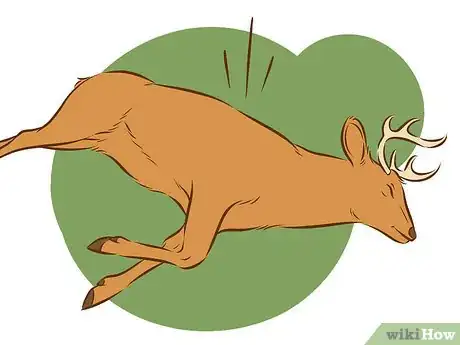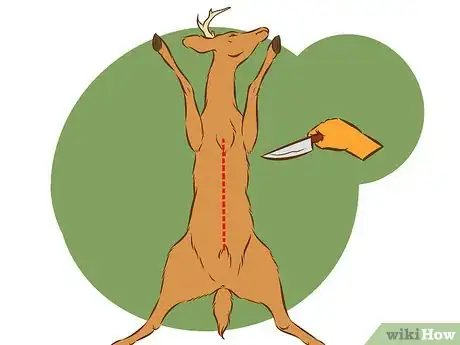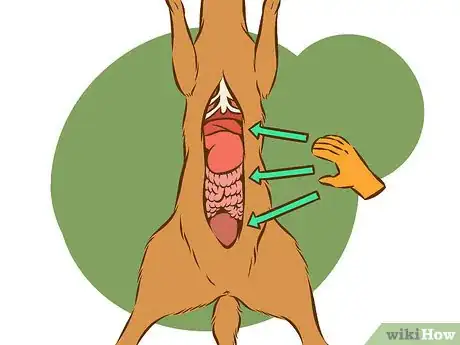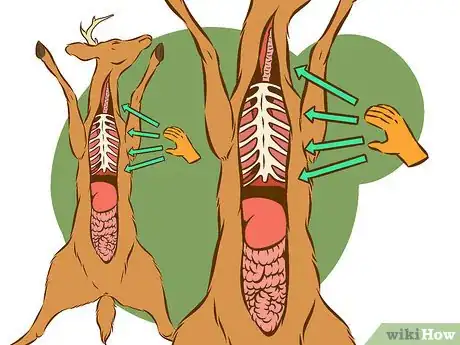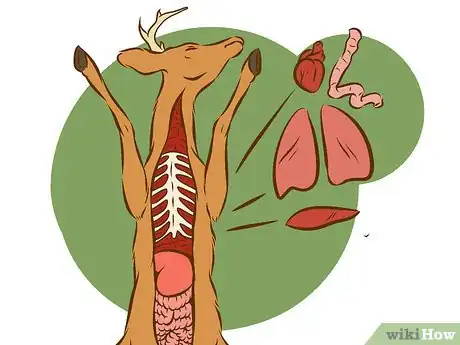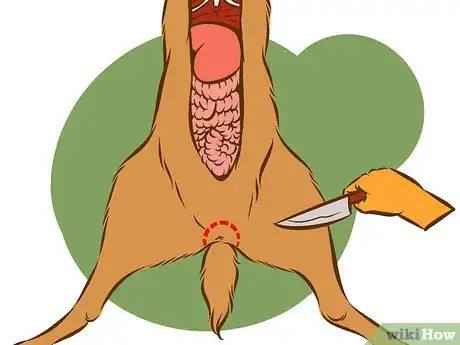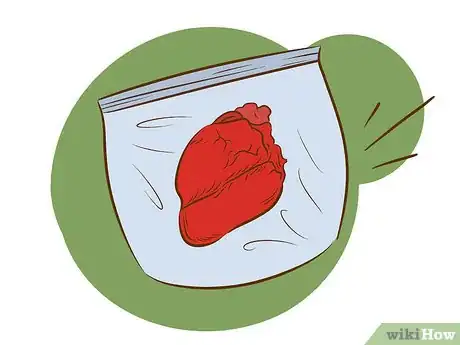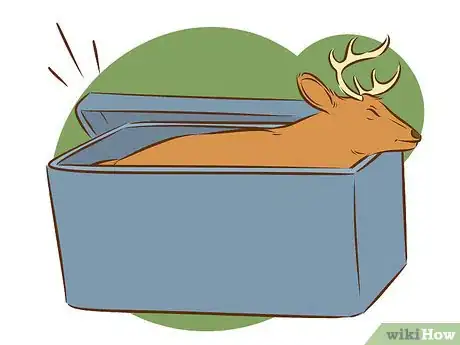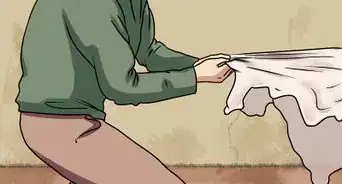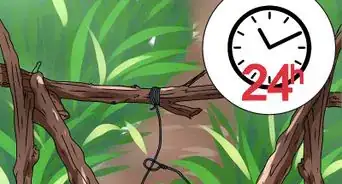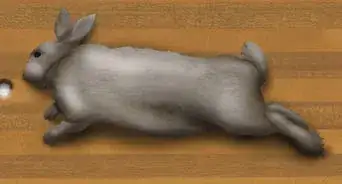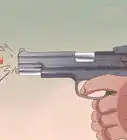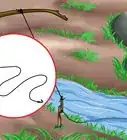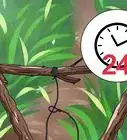wikiHow is a “wiki,” similar to Wikipedia, which means that many of our articles are co-written by multiple authors. To create this article, volunteer authors worked to edit and improve it over time.
This article has been viewed 53,268 times.
Learn more...
You've gotten your first deer kill. Now what? You will need to field-dress the animal and dispose of the innards. Read below to learn how to field-dress a deer to ensure that your venison will taste its best.
Steps
Remove the Abdominal Organs (Except Digestive Tract)
-
1Confirm that the deer is dead. If needed, shoot it again. Do not approach a wounded deer on foot.
-
2Make the first incision on the belly. Lay the deer carcass on its back with legs spread. Locate the sternum or breastbone. Use a sharp knife to make an incision down the belly, from just below its sternum to its genitals. Your incision should be deep enough to cut the hide and the peritoneum (the thin membrane found just below the skin and over the organs). But be careful to not cut too deep. If you cut too deep you may puncture the organs and taint the meat.[1]
- After the initial incision near the sternum, make the rest of the cut with the knife blade facing up. This helps prolong the blade's life (as it is not cutting through the fur) and minimizes the chances of you accidentally puncturing an organ.
Advertisement -
3Remove most of the abdominal organs. Use a small sharp knife to free the abdominal organs from any membranous adhesions. Once cut free, use your hands to remove the bladder, kidneys, liver, spleen, pancreas, and internal genitalia.
- When removing the bladder be careful that you do not spill any contents. To prevent any urine spilling, pinch off the bladder with one hand and slowly cut it free and remove the bladder with the other hand.
- Take special care to not accidentally cut the intestines or the spleen, as their spilled contents will ruin meat.
Remove the Thoracic Organs (Except Digestive Tract)
-
1Access the thoracic organs. After most of the organs are removed from the abdominal cavity, it is time to clean out the thoracic or upper chest cavity. To access the thoracic cavity, use a sharp knife to cut through the muscle (diaphragm) and membrane that separates the thoracic cavity from the abdominal cavity.[2]
- Expect to find a lot of blood when you cut into the thoracic cavity.
- Be careful when working in the thoracic cavity. If the deer was shot in the chest there may be sharp broken ribs.
-
2Remove the thoracic organs. Use a small sharp knife to free the thoracic organs from any membranous adhesions. Follow the trachea (windpipe) up as far as you can and cut it free. Once cut free, use your hands to remove the lungs and the heart.
Remove the Digestive Tract
-
1Free the top of the digestive tract. The digestive tract, is the continuous tube through which food travels, and consists of the esophagus, the stomach, the intestines and the rectum. The digestive tract is best removed in one piece. To remove the digestive tract in one piece, you will need to free both ends. To free the top end or esophagus (swallowing tube leading to the stomach), reach up into the chest cavity as far as you can and sever the esophagus. Then pull this end down, through the chest and out.
-
2Free the bottom of the digestive tract. Next you need to free the lower end of the digestive tract or rectum/anus. To do this cut a deep ring around a buck's anus, or a deep ring around a doe's anus and vagina. Stuff the now freed rectum back into the body cavity, and out through the stomach incision.
- The cut around the anus should circumscribe the anus but not cut the anus. The goal is to free the anus from the surrounding tissue, while leaving the digestive tract, including rectum, intact. Your cut around the anus should be about 4 inches (10.2 cm) deep.
-
3Pull the digestive tract out. Now that both ends of the digestive tract are free you can roll the intact digestive tract out of the body cavity.[3]
- As you handle the digestive tract, be careful not to cut the intestines, or squeeze fecal matter out. Spilled fecal matter will taint the meat. You may choose to tie off the rectum to minimize spillage.
Clean up
-
1Save edible organs. You may choose to eat the heart and liver. However, it is not recommended that you consume the brain, spleen, eyes, tonsils, or lymph nodes. Put any organs you plan on saving in a clean plastic bag.[4]
-
2Dispose of waste. If it is okay with the property owner, you may leave the waste organs (intestines, spleen, etc) for scavengers. Otherwise, pack up the organs in another plastic bag to bring with you.
-
3Take your deer home. Transport your deer home. Get your carcass chilled, or on ice, as soon as possible.
Things You'll Need
- Sharp knife
- Disposable gloves
- Plastic bags
- Water and towels (optional) for cleanup
- Drag rope (optional)
References
- ↑ https://mdc.mo.gov/conmag/2003/09/skinning-and-cleaning-deer
- ↑ https://www.hunter-ed.com/washington/studyGuide/Field-Dressing-a-Deer-Detailed-Instructions/20105001_700046905/
- ↑ https://www2.illinois.gov/sites/agr/Animals/AnimalHealth/AnimalDiseases/Pages/CWD-Processing.aspx
- ↑ https://bowhunting360.com/2018/04/03/i-shot-a-deer-how-can-i-use-everything/
About This Article
To clean a deer, start by cutting it open lengthwise down its belly and pulling out its abdominal organs. Then, cut open the deer's upper chest cavity, and remove all of its thoracic organs, like the lungs and heart. Next, detach the upper digestive tract from the deer's esophagus, and pull it out. Finally, disconnect the lower digestive tract from the deer's rectum before removing it. For tips on how to dispose of your leftover waste, scroll down.
